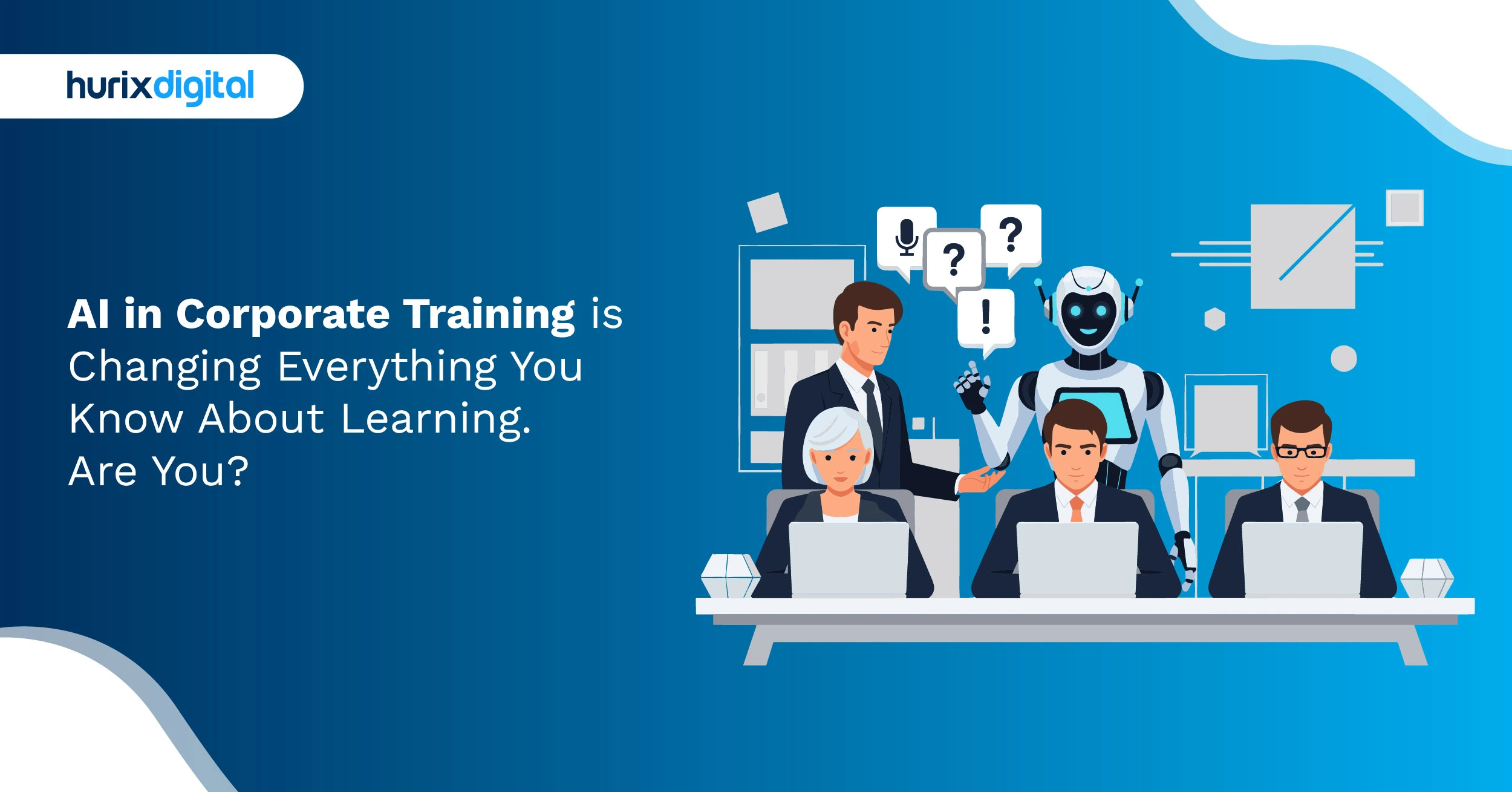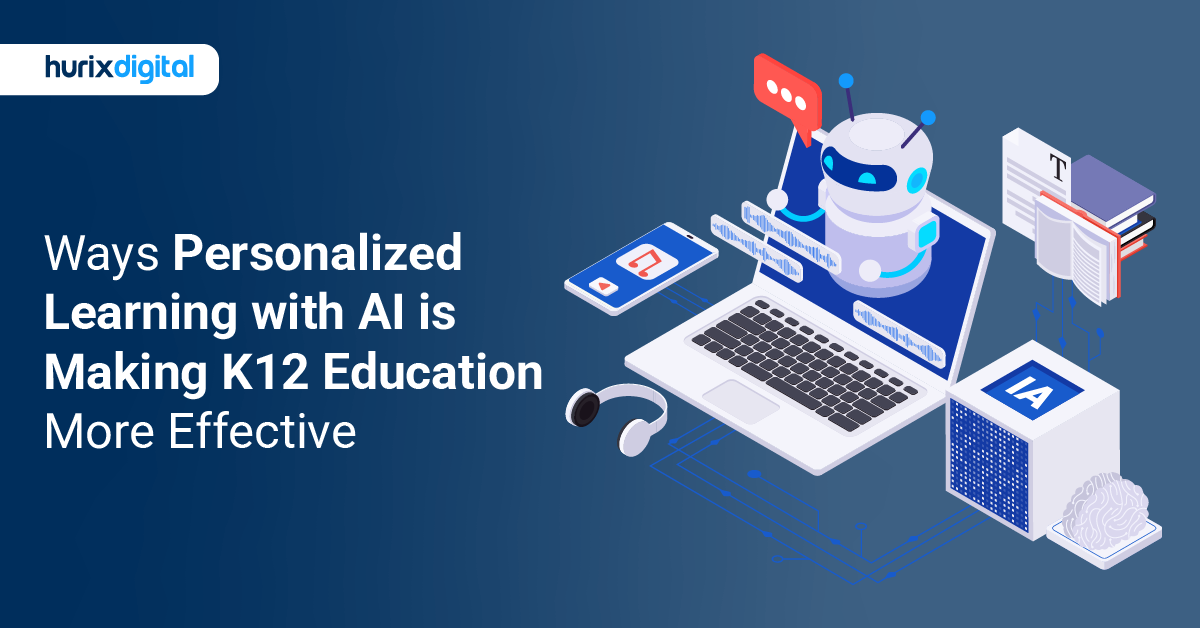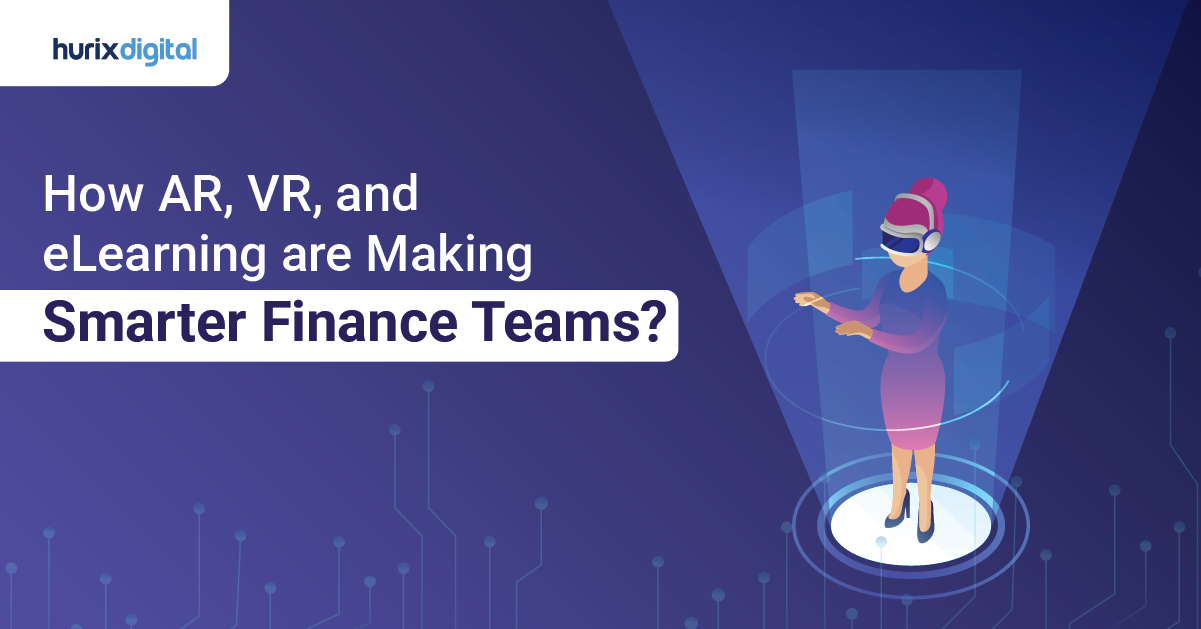
AI in Corporate Training is Changing Everything You Know About Learning. Are You?
Summarize with:
In a recent report published by the International Monetary Fund (IMF), it has been estimated that the rapid growth and development of AI will lead to around 40% of worldwide jobs being affected. This emphasizes the importance of upskilling and reskilling your employees to help them stay current with changing trends while ensuring their careers remain secure and fulfilling.
Continuous learning and development are essential for preparing your employees for tomorrow, ensuring their contributions to the organization’s success are not hindered. It also helps ensure smooth AI integration and maintains high employee morale and motivation.
Today, generative AI is used in many sectors, from manufacturing to architecture and engineering, and is now a $10.5 billion industry (as of 2022).
One sector where this technology holds tremendous promise and is gaining traction is the field of learning and development.
This blog will walk you through everything you need to know about AI in corporate training, along with its potential benefits.
Table of Contents:
- What is Generative AI?
- Challenges with Generative AI in Learning and Development
- How Do You Address the Challenges That Come with Using Generative AI?
- What are the Use Cases of Generative AI in Corporate Training?
- What are the 3 Most Engaging AI-Powered Learning Solutions for Corporate Training?
- Key AI Concepts for Learning Professionals to Improve Skill and Knowledge
- Need for Employee Development in AI Integration
- 5 Key Benefits of an AI-Based Learning Management System (LMS)
- Final Thoughts
What is Generative AI?
Generative AI is a subset of artificial intelligence (AI) that can create new and realistic content, such as images, text, music, or code, using machine learning techniques.
Unlike traditional AI, which can only perform specific tasks based on predefined rules and instructions, generative AI can learn from data and generate original and diverse content that resembles human-created content.
AI-powered learning initiatives can leverage this ability to support learning and development professionals in numerous ways.
Challenges with Generative AI in Learning and Development
While AI in training and development holds tremendous potential, it poses a few challenges, like:
1. Data Quality and Accuracy
Generative AI “learns” from existing data, so any inconsistencies, noise, or outdated information tend to reflect in the output of these models. This technology is also prone to hallucination – in simple terms, it can fabricate facts and confidently assert them.
Any biases in the training data will also tend to be reflected in the output of these models, which can have a negative impact by ingraining these biases during training.
2. Ethical Considerations
Generative AI models tend to infringe on copyrights and sometimes plagiarize when generating content. The infamous high-profile case of Getty vs. Stability AI is a prime example.
3. Data Security
Generative AI models can create content that may be sensitive or confidential for corporate training purposes. For example, they may generate content that contains personal or confidential information, or that reveals trade secrets or proprietary strategies.
How Do You Address the Challenges That Come with Using Generative AI?
Technology can be both a curse and a blessing, and it all comes down to how one uses it. That said, generative AI in corporate training and learning and development ticks all the boxes L&D professionals need to stay on top of the dynamic environment they work in.
The challenges mentioned above can be overcome or mitigated to some degree by adhering to a few best practices.
The first and foremost practice to implement when using AI in corporate training is to have a system of checks and balances.
You could use third-party tools to verify the output of the generative AI model used for your training content.
As we have already established, technology isn’t perfect, so do not eliminate the human element as an additional layer of oversight. L&D professionals should establish a system that regularly audits and monitors this technology.
What are the Use Cases of Generative AI in Corporate Training?
Corporate training is not a field that can afford to be lagging. Regardless of the sector, technological advancements are rapid, and the rules and regulations surrounding compliance are constantly changing.
To reskill employees, L&D professionals must stay on par with these changes and develop training content accordingly. This is where artificial intelligence in corporate learning can be a lifesaver.
Here are a few use cases where Generative AI in learning and development can improve learning initiatives.
1. Generate Learning Content
Any form of training requires the development of content in some shape or form. Traditional methods of doing so are labor and time-intensive and incur significant costs in terms of human resources required.
Generative AI in learning and development can address this problem by generating detailed and comprehensive training materials in a multitude of formats at a fraction of the time and cost.
2. Impart Personalized Training
Personalized learning has emerged as one of the top trends in corporate training. Its “adaptive” nature allows it to impart the best possible learning at a pace and complexity that works best for each employee.
This personalization, made possible by utilizing AI in eLearning, has a proven track record of enhancing knowledge retention and increasing engagement levels. The same technology can be used to introduce gamification into your training program.
In conjunction with the data analytics capabilities of AI, L&D professionals can also gain valuable insights into the current state of their internal teams’ competencies and plan for additional training exercises accordingly.
3. Use NLP to Summarize Content
Generative AI works on the fundamentals of Natural Language Processing. L&D professionals can harness the capability of AI in corporate training and incorporate a feature into their training content that summarizes complex concepts clearly and concisely.
Doing so can help L&D professionals:
- Shorten training sessions, thus imparting effective training with minimal impact on employee productivity.
- Improve comprehension of complex topics without information overload and enhance retention of the knowledge imparted.
What are the 3 Most Engaging AI-Powered Learning Solutions for Corporate Training?
The influence of AI extends beyond theoretical concepts, creating practical and engaging learning offerings for corporate training.
1. Virtual Reality Simulations
Virtual Reality (VR) helps corporations create immersive experiences that simulate real-life scenarios for practical training in a safe and productive environment. Experiential learning encourages better retention through practical experiences so that knowledge is not simply taken in but deeply ingrained.
This has caused organizations to reconsider their approach to hands-on learning as VR-based training becomes easier to use due to its increasing cost-effectiveness and reliability.
2. Instant Learning Support
AI-driven chatbots and teaching tools offer immediate support for queries, helping to remove barriers to instant learning. The availability of 24/7 learning increases accessibility to ensure that individuals can seek specialized assistance whenever needed.
AI’s ability to process natural language commands makes interactions more seamless and user-friendly.
3. Gamification of Training Modules
Gamified elements in learning modules enhance the fun of training and increase engagement. Achievement badges and rewards can serve as motivational tools, encouraging continuous participation and a prolific attitude.
A healthy sense of competition can help facilitate a dynamic learning environment, enhancing the overall training experience for all learners.
Key AI Concepts for Learning Professionals to Improve Skill and Knowledge
Here are 11 key AI concepts for learning professionals to improve their skills and knowledge:
1. Machine Learning
Machine learning lies at the heart of AI, empowering systems to learn from data and improve over time without explicit programming. Specialists in this field must understand various types of machine learning, including supervised learning, unsupervised learning, reinforcement learning, decision trees, neural networks, and support vector machines, among other common algorithms.
Once you know what they are capable of doing, it becomes possible to create adaptive systems for teaching or recommendation engines for personalization that will optimize results based on predictions made by predictive analytics models using ML.
2. Natural Language Processing (NLP)
Natural Language Processing enables computers to understand human speech and writing, allowing them to communicate with people more effectively. There are many ways educators might apply NLP.
This includes generating chatbots that respond in natural language to learner queries or analyzing large bodies of text for insight extraction towards intelligent tutoring system development. These programs would be able to understand the questions learners ask and express them naturally.
3. Deep Learning
Deep learning, a branch of machine learning (ML), focuses on artificial neural networks with multiple layers that enable complex data representation. Understanding deep learning allows educators to create advanced AI applications.
Some of them are speech recognition systems, image classification algorithms, and models for natural language understanding, thus changing the way we deliver and assess content.
4. Computer Vision
Computer vision enables machines to interpret and understand visual information from their environment. With vision and cognitive computing techniques, teachers can create immersive virtual reality (VR) and augmented reality (AR) learning experiences.
Moreover, they can automatically tag and classify content and improve assessment through technologies like facial recognition or emotion detection.
5. Recommender Systems
Recommender systems utilize AI algorithms to analyze user preferences and behavior, providing personalized recommendations on what to consume next. Educators need to learn how recommender systems work.
That is how they can design adaptive learning platforms, curated learning pathways, and targeted content delivery strategies for individual learners based on their needs and interests.
6. Generative Adversarial Networks (GANs)
GANs comprise two neural networks: the generator and the discriminator. These networks learn by competing against each other, which helps them produce realistic synthetic data.
For example, GANs can be used in educational programs to create virtual laboratories. They can also generate training sets for unusual cases or those that require privacy. Moreover, content developers may find them useful when creating lifelike videos, texts, or images.
7. Ethical AI
AI ethics is a top concern when working with educational systems. Teachers must account for fairness issues tied to algorithmic bias and student privacy vis-à-vis machines’ use of their personal information.
Additionally, moral questions surround automated decision-making through AI in corporate training and L&D environments. To ensure equal opportunity and gain students’ confidence in these programs, instructors need to follow ethical guidelines while being transparent about their intentions.
8. Data Privacy and Security
As AI-powered learning technologies become more common, protecting the privacy of student data and ensuring cybersecurity have become essential duties for educators.
Awareness of data protection regulations, such as GDPR, and implementing strong security measures can help reduce the risk of breaches or unauthorized access while keeping learners’ trust intact.
9. Explainable AI (XAI)
Explainable AI aims to clarify artificial intelligence models so that different stakeholders can easily understand how decisions are made based on them.
Learning professionals should prioritize XAI techniques since they enable students to learn more about themselves through assessments made by algorithms driven by this system. This system also recommends personalized AI in learning and development materials, thereby enhancing comprehension and trust in an environment where machines are involved in everything.
10. Transfer Learning
Transfer learning refers to when the knowledge gained from one task is applied to another related task, thereby speeding up AI learning and development and improving how models generally work.
Resource allocation optimization and adaptation of pre-trained AI models may be necessary to match specific educational settings, among other things. Transfer learning methods can achieve this, allowing teachers to maximize knowledge sharing across different domains.
11. Continuous Learning and Adaptation
Due to the rapidly changing nature of AI and education, it is essential to adopt a culture of continuous AI integration in learning and development. This will help experts in the field keep up with current trends, new technologies, and best practices.
By participating in career advancement activities, working with teams from various disciplines, and trying out novel methods, professionals can improve their skills with artificial intelligence’s progress, thereby fostering innovation within teaching institutions.
Need for Employee Development in AI Integration
Employee development in terms of AI integration and readiness is essential for every business because:
- Training employees in AI will boost their efficiency and productivity, enabling them to tackle more complex tasks.
- With AI integration and proper training, employees can quickly and accurately process large datasets, thereby improving their decision-making. Access to real-time insights and analytics also facilitates the learning and development of these skills.
- AI helps your employees identify new opportunities for innovation, making your organization more competitive.
- Employees will feel more satisfied when organizations provide workforce training for AI readiness because they get the opportunity to grow professionally and personally. This will also improve their loyalty to the organization, boosting employee retention.
- AI-trained employees can oversee and manage AI systems that handle tasks typically done by a large team. This allows organizations to scale operations more cost-effectively.
- Lastly, an AI-trained team boosts the ability to streamline processes, reduce errors, improve productivity and efficiency, and optimize resource usage.
5 Key Benefits of an AI-Based Learning Management System (LMS)
Let’s take a look at five benefits of using AI in LMS:
1. Seamless Integration
It often happens that a trainer who is an expert in a particular field has to switch to a new role or field. Adapting to a new environment and learning system can be quite challenging for an individual.
AI-powered LMS reduces the human effort required for this task and enhances productivity. Moreover, AI-powered LMS can be easily integrated with other educational tools, CRMs, HR systems, and communication platforms, smoothing workflows and data management and making the job as less stressful as possible.
Without the hassle of multiple systems, data gets shared in real-time, ensuring accuracy and consistency throughout the organization.
2. Immersive Learning
AI-based LMS can create an environment of intuitive and immersive experience for users. With the integration of AI learning tools, content management can be automated.
The AI feature enables easy import and export of training content across various channels. This will benefit the creation of more engaging and customized content and enhance its effectiveness.
Incorporating gamifying elements such as points, badges, and leaderboards might even create higher user engagement or motivation. Using the data gathered from these sources, AI can create personalized learning paths tailored to individual needs and preferences.
An AI-powered LMS also creates immersive and interactive learning experiences using virtual reality.
3. Time-Saving
AI can automate repetitive tasks typically performed by administrators and trainers, such as grading student assignments and generating reports. This will reduce costs, save time, and lower manual effort, allowing trainers and administrators to focus on more important tasks and increase efficiency.
Furthermore, an AI-powered LMS provides individualized support to learners, thereby minimizing the need for one-on-one tutoring and saving instructors’ time. These systems also adjust the learning pace and content according to the rate at which each learner progresses, thereby optimizing learning time.
4. Chatbot Assistance
Remote and virtual learning have become normal in recent times. To aid this process, AI and chatbots have played a significant role. Users can get 24/7 support from chatbots virtually from anywhere in the world to resolve their queries or issues. Human intervention is highly reduced with this AI feature in learning management systems.
An AI-based chatbot can answer a learner’s question instantly and solve any problem arising at any time. Chatbots even suggest available resources or learning paths to learners based on their interests or the goals they want to achieve in a course. By understanding and responding to natural language queries, AI chatbots in LMSs make interactions more intuitive and efficient.
5. Learner-Centric Training
AI in LMS helps create a personalized learning experience for learners. Learner data can be analyzed by AI to identify areas where learners are likely performing poorly or struggling. Therefore, the support that the instructors can apply to such topics is provided by AI.
AI-powered LMS also provides learners with immediate feedback, so they know what they need to do to improve and remain focused on the task at hand. By taking into account each learner’s different learning styles and preferences, AI can produce highly personalized learning experiences.
Final Thoughts
As tech continues to revolutionize the field of AI in corporate training, equipping learning professionals with a deep understanding of key AI concepts is paramount to unlocking its full potential.
Therefore, by being proficient in machine learning (ML), deep learning (DL), and Natural Language Processing (NLP), among other foundational ideas about artificial intelligence (AI), teachers will be able to design life-changing educational experiences that empower learners while catalyzing a company’s growth, thus shaping future education.
Embracing ethical principles, prioritizing data privacy and security, and fostering a culture of continuous learning and adaptation are essential pillars for navigating the AI-powered learning landscape with integrity, responsibility, and innovation.
Whether you’re looking to enhance employee training, optimize educational content delivery, or elevate learner engagement, Hurix Digital‘s cutting-edge technology and expertise empower you to achieve your goals with confidence.
From customizable learning platforms and interactive content authoring tools to AI-driven analytics and personalized learning experiences, Hurix Digital offers a comprehensive suite of solutions tailored to your organization’s unique needs. Join hands with us to revolutionize learning and unlock the full potential of your workforce.
Summarize with:

Chief Learning & Innovation Officer –
Learning Strategy & Design at Hurix Digital, with 20+ years in instructional design and digital learning. She leads AI‑driven, evidence-based learning solutions across K‑12, higher ed, and corporate sectors. A thought leader and speaker at events like Learning Dev Camp and SXSW EDU
 A Space for Thoughtful
A Space for Thoughtful 



